Porridge with... Robin Herd
This man was one of the straightest guys in F1. So what’s he doing in jail? And just how did he get from racing to recycling?

As four new teams emerge this season to take on the Formula 1 establishment, there’s no shortage of doubters prophesying their early downfall. It’s an echo of exactly 40 years ago when, to almost universal cynicism, March suddenly appeared on the scene. Having done no more than build a single F3 car in a private lock-up, the new team boasted it would have two cars on the first F1 grid of the new season in South Africa, barely 16 weeks away. Few believed it would happen. March was an acronym of the initial letter of the four founders’ surnames – Mosley, Rees, Coaker and Herd – but the joke went that it stood for Much Advertised Racing Car Hoax.
As it turned out, there were five Marches on the Kyalami grid, and the two fastest qualified first and second. One led until quarter distance, and eventually finished third. March went on to win the next three F1 races, at Brands Hatch, Jarama and Silverstone. During the season no fewer than seven Marches ran in F1, and the new marque also featured in Formula 2, Formula 3, Formula Ford and Can-Am. It was, by any measure, an extraordinary first season.
What nobody knew at the time was that the much-touted sponsor, the US oil additive company STP, had only put in £10,000. Money was desperately short, and that August March nearly sank. It was only saved in the nick of time by a £17,500 loan from Max Mosley’s half-brother. Yet in 1987, with Robin Herd the only remaining partner, March went public, valued at £14.5 million – later rising on the Stock Exchange to around £35m.
Robin spent 20 years in full-time motor racing, and he doesn’t feel he has left it yet. Even so, he has done a lot of other things with his life, from bond trading to owning a football team and devising an ecologically beneficial energy and waste process. Unlike many racing people, he talks of his exploits, good and bad, with disarming honesty and lack of conceit – and an irrepressible sense of humour. His choice of lunch venue typifies this: the Malmaison in Oxford is the old city prison, and retains its iron staircases and even some of the cells. Robin gleefully mentions two mutual motor sport acquaintances who were guests there before the prison closed in 1996. Since then the food has evidently improved: in a corner of the old cell block we eat oxtail broth en croûte, entrecôte au poivre and crème brulée, helped along with a Rioja Crianza.
Robin was always a bright cookie. At school he excelled at Greek and Latin, and most sports. A classmate was Alan Rees, and they shared a monthly copy of Motor Sport, surreptitiously reading it under their desks. At 18 he got an offer to play cricket for Worcestershire, but won an open scholarship to Oxford instead, to read mathematics. Finding maths boring – “like doing The Times crossword every day” – he took up both physics and engineering, and got a Double First. He brushes this aside. “People overestimate all that. It was just down to being organised. It certainly wasn’t down to hard work: I never worked more than five mornings a week. The afternoons were for cricket, and other things.” My researches show he represented his college in 11 different sports.
At 22 he was a design engineer at the Royal Aircraft Establishment at Farnborough, working on computational fluid dynamics for Concorde. At 24 he was the youngest Senior Scientific Officer in the place. Then Alan Rees, now an F2 racer, got in touch. He’d heard that Bruce McLaren was looking for an aeronautical engineer to help realise his ideas for racing car design. “I went to see Bruce and Teddy [Mayer] that evening, and they hired me. McLaren consisted then of a wooden hut at Feltham with an outside toilet. Bruce was such a wonderful guy, and so was Teddy: they ran the place on a nice-cop-nasty-cop basis. Their people – Tyler Alexander, Wally Wilmott, Gary Knudsen, John Thompson, Don Beresford, John Muller, Howden Ganley – were the most able, focused group I’ve ever met in motor racing. Bruce said, ‘I’m off to the Tasman Series. While I’m away, design our first F1 car.’”
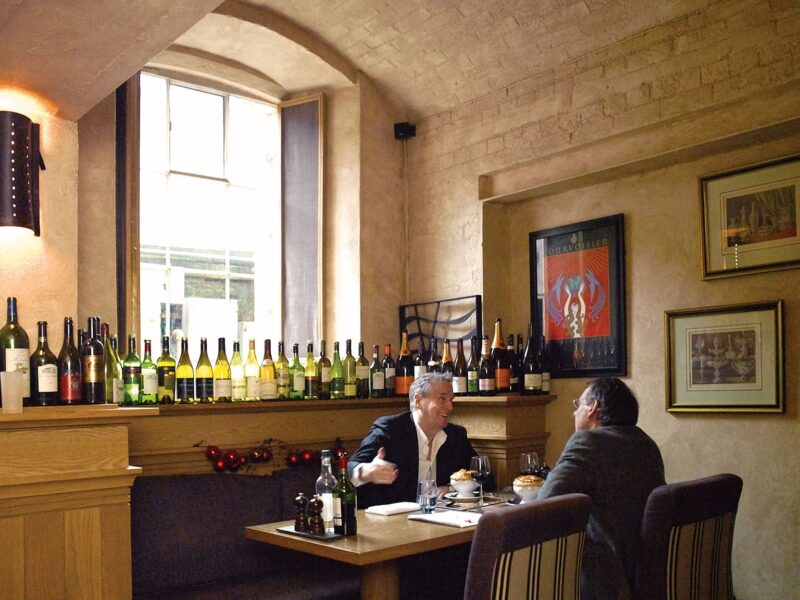
Herd’s quirky lunch venue choice was once Oxford’s prison
This was the M2A, initially used for Firestone tyre tests with an Oldsmobile V8 engine. Ever the innovator, Robin made the very stiff monocoque out of an aerospace material, an aluminium/balsa sandwich sheet called Mallite. Then he came up with an idea to use wings on a racing car. “The lads all took the mickey, telling me a racing car was meant to stay on the ground, not take off. But we made something up and ran it at the end of a three-day test at Zandvoort in late 1965. Instantly the car was three seconds a lap faster. We took it off, three seconds slower. We didn’t want anybody else to know, so we took the wing home, sawed it in two and put it in the bin, saving the idea for later. We ran the M2B in F1 with a linered-down version of the four-cam Indy Ford V8, but that was such a struggle we gave up any thought of being competitive. It was more than two years later that Ferrari and Brabham came up with the wing idea.”
Robin designed the F2 M4, which also ran in F1 events as the M4B with 2.1-litre BRM V8; then the F1 M5A with BRM V12 power; then the M6A Can-Am car. “That really created the DNA for all the Can-Am McLarens. I worked out how we could run ground effect at the front, with a spoiler at the back to balance it. We tested at Goodwood with me stuffed into the passenger side, and an anemometer to measure pressure under the car. By the time we got to Madgwick the needle was off the gauge. Bruce said, ‘Robin, I don’t want you to tell anyone about this. If Teddy knows, soon everybody will know.’ So nobody at McLaren realised that we had a ground-effect car. We balanced it out with a big spoiler on the back.
“Then I did the M7A, the first of the orange F1 cars. It won its first two races, then three Grands Prix, and was second in the Constructors’ Championship. But by then I’d already left. At the end of 1967 I accepted an offer from Keith Duckworth. Cosworth was the top company in motor racing then, and the DFV F1 engine ruled the world. Keith wanted to do a complete Formula 1 car for Jimmy Clark, using four-wheel drive, and he hired me to do it. The idea was to get Jimmy away from Colin Chapman. Jimmy was in on it, but I don’t think Colin ever found out. Then Jimmy was killed. The project continued as a design exercise, but it was a waste of time actually. Four-wheel drive wasn’t necessary now we’d got wings and wide tyres.
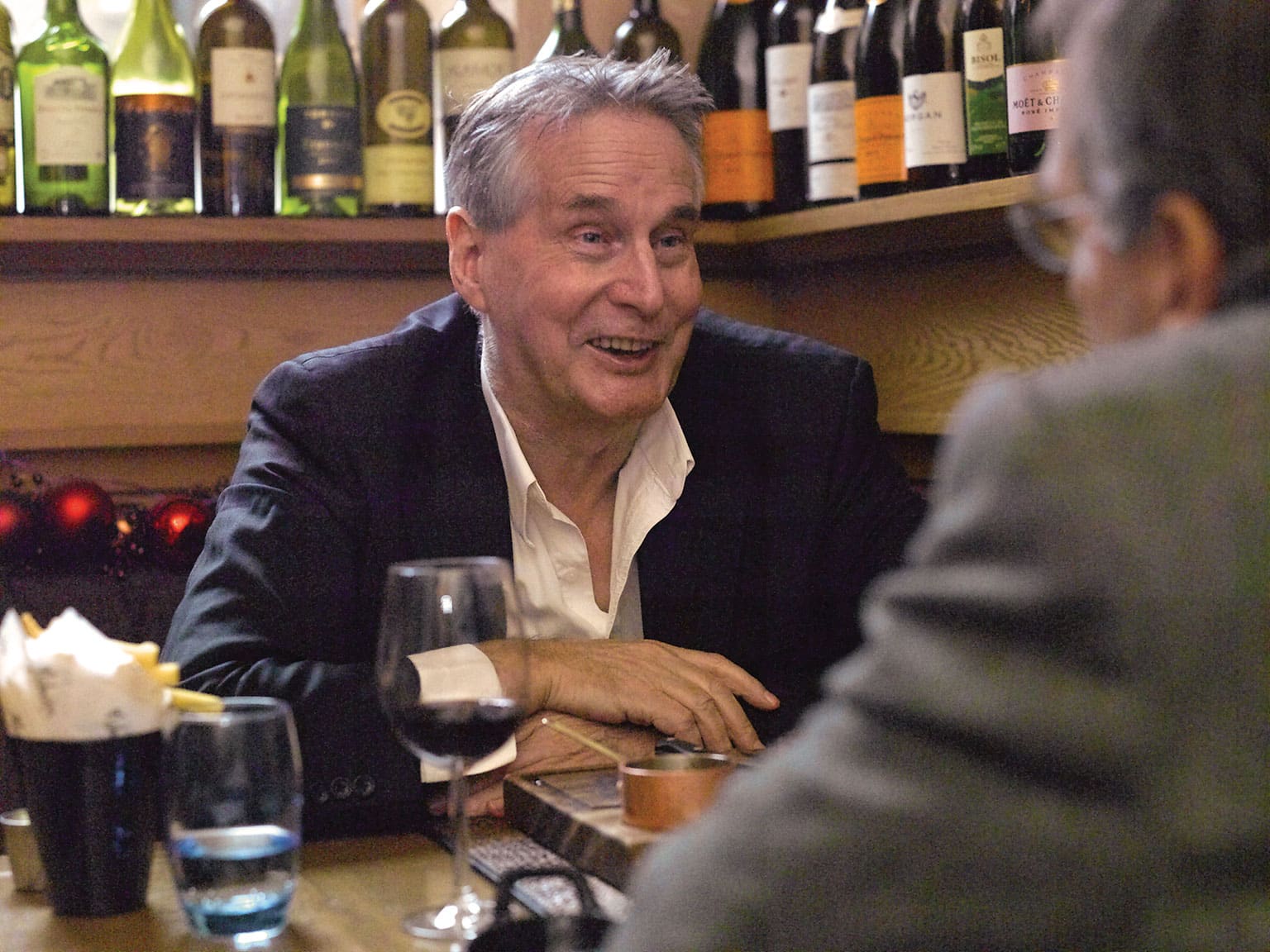
“Keith Duckworth had a phenomenal brain. I sat in a corner of his office for two years, and he didn’t suffer fools. I learned more about human nature and philosophy in those two years than I did about engineering. He had some wonderful sayings: like, ‘In engineering there is an answer to everything. We’re just usually too dim to see it.’ And, ‘People who tell lies have to remember what yesterday’s lie was. It’s much easier to be honest.’ He was an extraordinary guy. We did helicopter treasure hunts together in his Brantley 2B.”
In late 1968 Frank Williams asked Robin to re-engineer a second-hand Brabham BT26 to take a Cosworth DFV, so he could run Piers Courage in F1. Frank was looking after F2 cars for customers, including one for Max Mosley, whom Robin had known at Oxford. At Frank’s shop in Bath Road, Slough, they bumped into each other. Max, now a successful barrister, asked Robin over for dinner, and revealed his plans to found a major racing car company.
But other people were after Robin. At Winkelmann Racing, where Alan Rees drove with Jochen Rindt in F2, there was talk of an F1 car and an Indycar. Rindt, the most exciting rising talent of the day, was managed by somebody nobody knew much about, called Bernie Ecclestone. “Things were already developing with Max when Bernie approached me to do a Formula 1 car for Jochen. It was a fork in the road. If I’d gone with Bernie and Jochen, March wouldn’t have happened, and my life would have been very different. But Bernie says he wouldn’t have let me get as rich!
“Bernie is absolutely the most able person I have ever met, in any walk of life. If you behave correctly to him you will never have a better friend. There are one or two people who don’t say that about Bernie, but you’ll find it’s their fault. But I didn’t know Bernie then, and I had to make a decision, so I went with Max.”
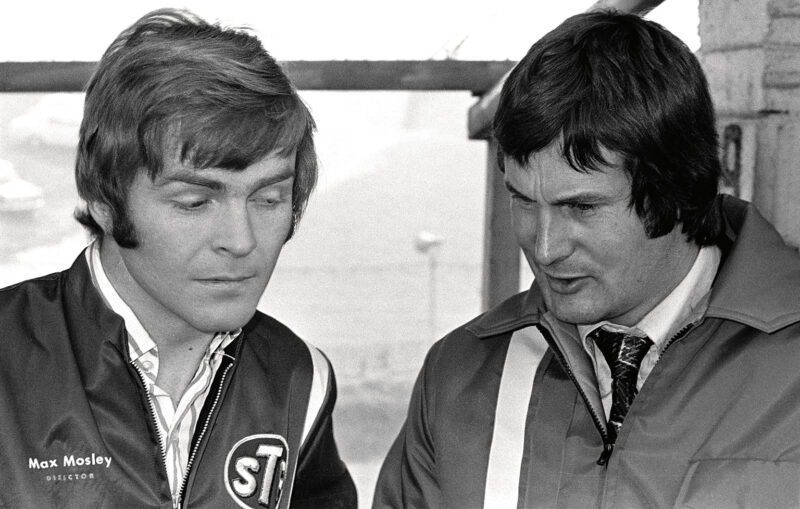
Herd and March co-founder Max Mosley
Motorsport Images
The ambitious Mosley naturally wanted Rindt to be part of his new operation, which by now also included Rees and F3 racer Graham Coaker as production man. But there were still no premises, and the prototype F3 car was being built in the garage of Coaker’s house. In the end Rindt decided to stay with Lotus. Despite Mosley’s blandishments, he was not prepared to throw in his lot with an outfit which had only one F3 car “built in Graham’s shack”. Jochen’s Austrian accent rendered this as “Grem’s sheck”, so at first the fledgling company was named, with typical humour, Gremsheck Engineering.
Max wanted to call the new marque Apollo, because that would put it near the top of any alphabetical list. “With about five minutes left before we had to register the name I said, ‘Let’s do an anagram of our initials. M, H, R, C, plus a vowel to make it work.’ We could have called it Charm, but I didn’t think that was quite right.
“Max lived in London, I was in Northampton, so we drew a big circle on a map, rang a lot of estate agents, and found 3000 square feet in Bicester. We were the start of quite a cottage industry that has evolved in the area – people who can make exhaust pipes, or do machining, or glassfibre. In time Reynard, ATS, BAR and others gathered around there. But what we got was just an empty box with a telephone. We pulled in a fabulous little group of people – Bill Stone and Ray Wardell were the first two employees, Alan brought Pete Kerr from Winkelmann, and we persuaded guys like Bob Dance, Roger Silman, John Thompson and Dave Reeves to join us. Without those wonderful people we would never have even got started. Money was incredibly short. We agreed that each of the four partners should put in £2500 to get us going. I didn’t have £2500, so I borrowed £1000 from my mother and got her to put a bet on Jackie Stewart to win the 1969 World Championship at 2.5 to 1.”
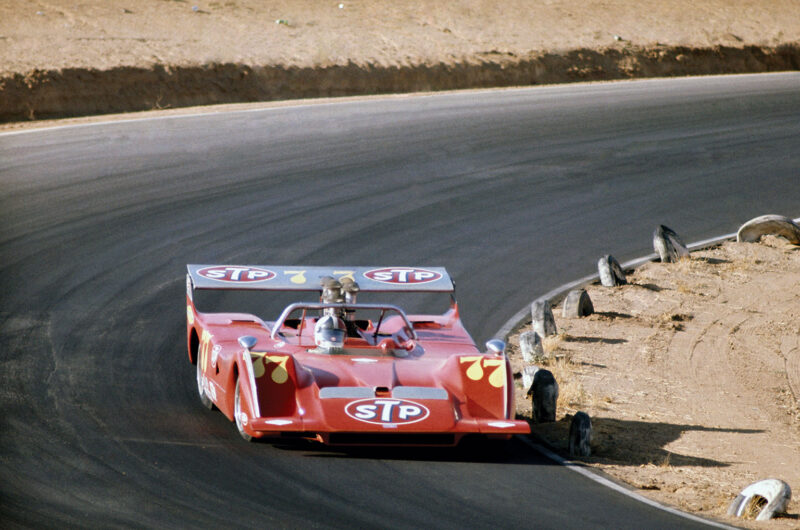
Mammoth 707 was a Can-Am contender
Motorsport Images
Ronnie Peterson gave the F3 prototype a promising debut at Cadwell Park at the end of September, but crashed it heavily at Montlhéry a week later. Ray Wardell dragged him, injured, from the burning wreck. Then, in early November, Max announced March’s F1 plans to an incredulous motor racing world: works cars for Chris Amon and Jo Siffert, Tyrrell buying cars for Jackie Stewart and Johnny Servoz-Gavin, STP boss Andy Granatelli fielding a car for Mario Andretti, and Ford of Germany ordering one for Rolf Stommelen. “Max told me we were going to have a press launch at Silverstone for the F1 cars on February 6, which was 12 weeks away, with the first race at Kyalami four weeks after that. I thought, oh f***. We just had to get on with it, working flat out day, night and through the next day as well. I lost a stone and a half.
“But I was disillusioned by the 701, because it was nothing like the car I wanted to build. We had to cut so many corners. It did the job, it qualified 1-2 for its first Grand Prix and it won three of its first four races. But it was so crude. It had to be: we didn’t have the money, or the time, to do anything else. If I’d gone with Bernie and Jochen I would have done a 711 straight away, with real ground-effect sidepods. The 701 needed additional side tanks for some circuits and Peter Wright at Specialised Mouldings styled them as aerofoil sections. In a press release I said they were to add stability, but that was hype. In the turbulent air between the front and rear wheels they won’t have done much. But Peter was looking for downforce. He really deserves the credit for ground-effects, for what he did when he went to Lotus.
“Max calculated the 701s cost £3000 to build, so he charged them out at £6000, which we thought was a pretty good mark-up. Walter Hayes of Ford – who was paying for the Tyrrell cars – warned us it wasn’t enough, and told us to charge him £9000. But all the hints Max dropped at the launch about big secret sponsors were smoke and mirrors. Lack of money meant the engines in the works cars would have to go longer between rebuilds, and everything, even the shock absorbers, had to have a longer life.
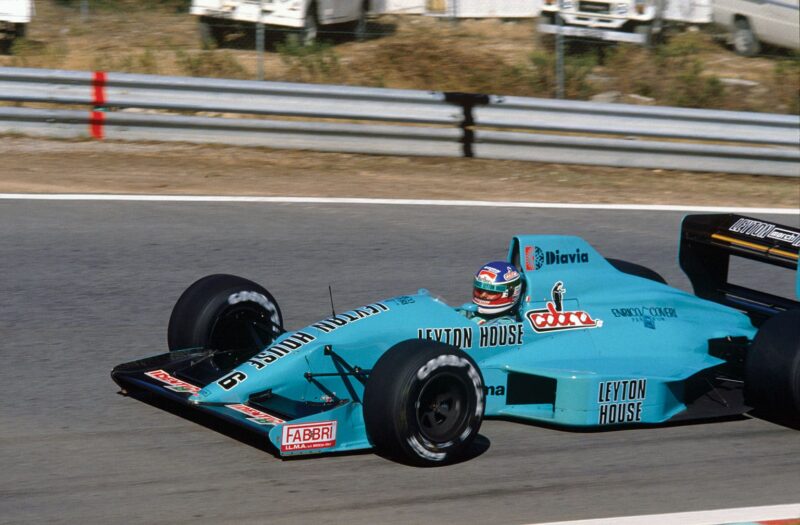
Leyton House project kept Herd in Formula 1
Motorsport Images
“I’d got to know Chris [Amon] very well at McLaren – a lovely guy, a very, very fast driver, and a very sensitive one too. Maybe all he lacked was self-belief. But he and Max never hit it off, there was always antagonism there. Chris believed the whole team was going to be wrapped around him. But, after he’d signed, Porsche offered us £30,000 to put Seppi [Siffert] in a car, to keep him out of Ferrari. In retrospect Max would have liked Seppi as No?1 and Ronnie as No?2, which would have saved a lot of money.”
Jackie Stewart won March’s second Grand Prix, the Spanish in April, and 701s clocked up four second places – Stewart at Zandvoort and Monza, Amon at Spa and Clermont-Ferrand. At season’s end March was third in the Constructors’ Championship, four points behind Ferrari. Amon could have won Watkins Glen but for a puncture, but the victory that should have been his was at Spa, which he led only to find that Pedro Rodríguez’s BRM had astonishing straightline speed. “It’s generally accepted now that Pedro had a 3.3-litre engine that day. We knew it right after the race, but putting in a protest wasn’t the sort of thing you did in those days.” Meanwhile customer cars for the other formulae had to be designed and built – F2, F3, Formula Ford, even Can-Am: Chris raced the huge 707 in several American rounds, splitting the mighty McLarens at Donnybrooke until slowed by fuel problems.
Graham Coaker, unhappy at the F1 operation sapping funds from the production side, left in September. He took with him a 712 chassis. The following Easter he crashed it at Silverstone: a broken leg turned to septicaemia and tragically, two months later, he died. At the end of 1971 Alan Rees decided to leave, going on to Shadow and later Arrows with Jackie Oliver.
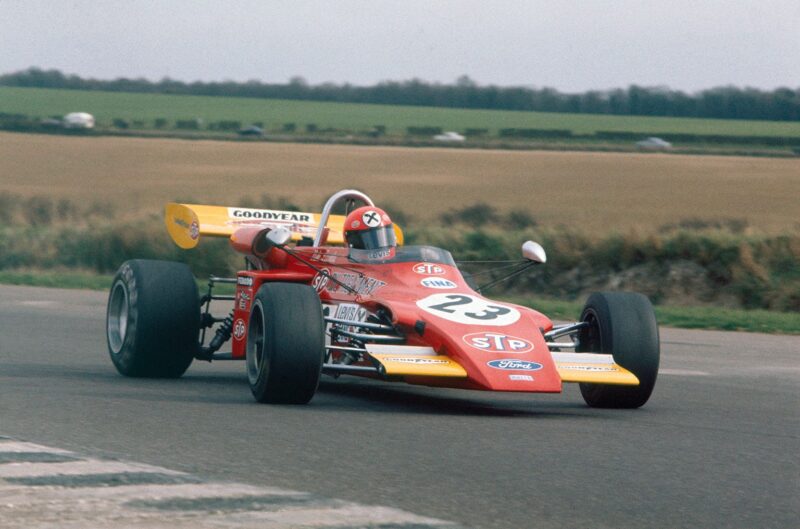
Nikki Lauda heads for third in a Thruxton F2 race in 1972 in the 722 that would become the basis for a GP racer
Motorsport Images
While the 701 had been conventional, the 711 was different. The bodywork was shaped by aerodynamicist Frank Costin, with rounded bullet nose carrying a wing on a central strut. “Frank was a lovely guy. We suggested a flat fee, but he insisted on payment by results – so much per mph increase in straightline speed. At the first Grand Prix at Kyalami Ronnie was following John Love’s 701 down the straight, and couldn’t pass him. So Frank was never paid.” Ronnie’s engine, conveniently for the cash-strapped Bicester team, must have been down on power that day. “In fact the 711 was a very good car, with good airflow through the suspension and some ground effect.” Peterson – in his first full year in F1 – finished second in the World Championship to Stewart. But, having lost more money during the year, March only survived the winter because an ambitious, buck-toothed little 23-year-old called Niki Lauda arrived with cash from an Austrian bank, £35,000 for an F1 drive and £8000 for an F2 drive. He took his place in the 1972 team alongside Peterson.
“Ronnie was one of my best-ever friends. A fabulous driver and a lovely human being. He could fool himself, just like I could. Like with the first 1972 car, the 721X, which was dreadful. This was the car with the gearbox ahead of the rear axle line, to get a lower polar moment of inertia. But the first thing you have to do with a racing car is keep the tyres happy, and the 721X didn’t do that. Going into a corner it understeered madly, then it’d snap into sudden oversteer. We both so wanted it to work, and Ronnie tried so hard, then Niki got into it. Niki always spoke as he found, and at once he said, ‘This is shit.’ He was absolutely right. We replaced it with the F2-based car, which we called the 721G – G for Guinness, because in desperation we produced it in nine days, which we thought was good enough for the Guinness Book of Records.”
Ronnie’s best finish in the 721G was third at the Nürburgring behind the Ferraris, despite a spin, but he ran second for much of the Canadian GP. Then at Watkins Glen he crashed heavily in practice. “To repair it we needed some steel, and we didn’t have any. So that night we drove into the town, searched around until we found a house with a steel gate, stole it off its hinges and made a new bulkhead out of it. Ronnie started 26th, and stormed through to finish fourth.”
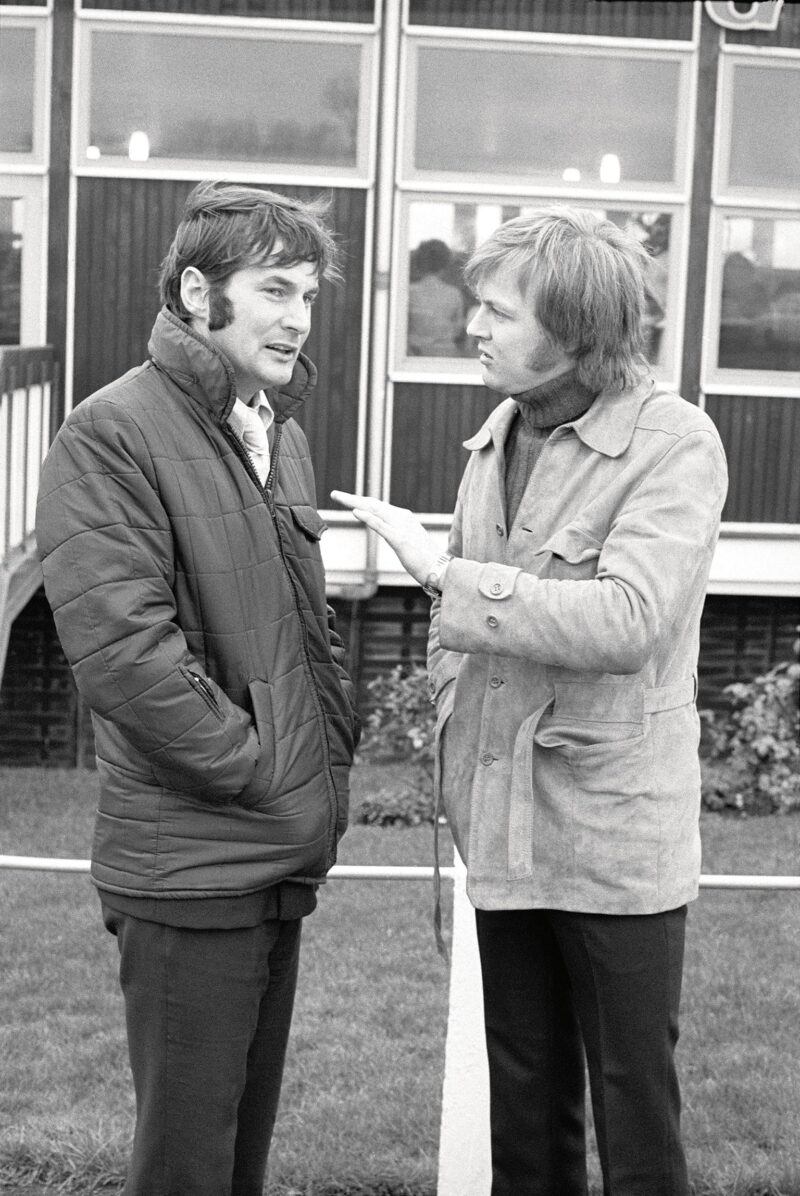
Robin with Ronnie Peterson, a close friend and loyal March driver
Motorsport Images
For 1973 Peterson went to Lotus, Lauda to BRM, but March continued to play a prolific role in F1, partly because it would sell a car to anyone who could pay. That season its cars appeared under five different entrants, one being Lord Alexander Hesketh. He bought a car for his friend James Hunt, who took a brilliant second place at Watkins Glen, less than a second behind Peterson’s Lotus. There was a lot of F2 success, but it wasn’t until 1975 that March’s first works Grand Prix win came in Austria, with Vittorio Brambilla. Before that there was a remarkable pole position in the Swedish GP.
“It never occurred to me to cheat in F1, and I was never aware of anyone else cheating – well, apart from the BRM engine at Spa in 1970. From time to time one or two people ran big engines when their sponsorship was up for renewal. Or there might be a weight thing here and there. Oh, and the pit board in Sweden. In qualifying I was given the vital job of holding out the board, and our pit was just by the light beam at the finish line, and maybe I just happened to swing the pit board when Vittorio was still 50 yards up the road. Pole! But Vittorio was going well anyway. He led the race for 15 laps, until he had to stop for tyres.”
In Austria the race started wet but the weather was expected to clear, so most teams opted for compromise settings. Max had Brambilla’s car set for full wet. The weather went from bad to worse, and the race was stopped soon after half distance. “Vittorio was taking every risk, got by James Hunt’s Hesketh while they were both lapping slower cars, and led the race. Every time he came past in plumes of spray we said, ‘That’s the last time we’ll see him.’ Then they waved the chequered flag at him. He flung his hands in the air, and of course went straight into the barriers. Which led to all sorts of conspiracy theories – he’d had to crash the car to hide some evidence that it was illegal, nonsense like that.”
That season March’s No?2 driver was Lella Lombardi, backed by money from her sponsor, the aristocratic Italian Count Gughi Zanon. “Lella was a lot better than most people believed. But Ronnie was unhappy at Lotus – somehow he and Chapman never gelled – and at the first round of 1976, in Brazil, Ronnie said to me, ‘I want to come back.’ We agreed with Zanon to switch Lella’s money to Ronnie, and after second practice I went to his hotel room in São Paulo to talk about it. Then there was a knock at the door and a voice said, ‘It’s Colin.’ I dived behind the bed. Chapman came in and sat on the bed, with me hiding behind it. He’d found out Ronnie had talked to us, and for an hour he went on about what crooks we were, how we had no money – he was right about that – and all about Lotus’ grand plans for the year. After a bit I really needed to pee. I wonder what would have happened if I’d stood up and gone into the bathroom. Anyway I managed to hang on, and Chapman left eventually. For the next race, at Kyalami, Ronnie was a March driver again.
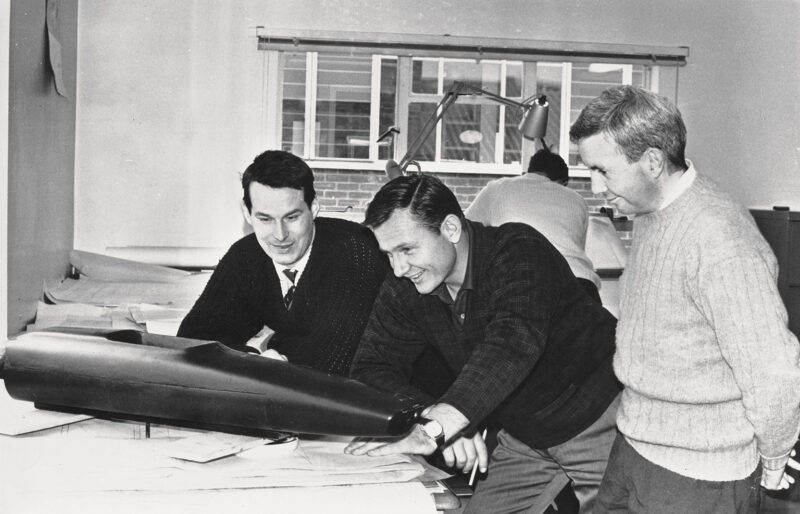
Herd discusses his first F1 design with Bruce McLaren and Teddy Mayer
Motorsport Images
“To save money we were only using F2 brakes on the F1 car, and they were never really up to the job. But, having taken pole and led at Zandvoort, Ronnie was brilliant at Monza. From eighth on the grid he was in the lead by lap 10. As usual his brakes started to go away, but fortunately showers of rain off and on during the race gave them a bit of respite. With Regazzoni’s Ferrari closing he set a new lap record with two laps to go, and won by 2.3 sec. We knew he was going to Tyrrell, but after the race he gave me the winner’s trophy. He said, ‘This is for you until I come back.’ A couple of years later, when he was with Lotus again and obediently following Andretti round in every race, he called in to see us at Bicester just before Monza. He said, ‘Robin, please make a decent car for me so I can come back. I know you can do it. Coming to March is always like coming home.’ A week later he was dead.”
In 1976 Tyrrell produced its six-wheel P34, but Robin reckoned it was all wrong. “With the big rear wheels there was no effective frontal area saving.” In reply he came up with the March 2-4-0, with four small driven wheels at the rear. “It went like a shell in a straight line, with much less drag because of its smaller frontal area, and it had phenomenal traction. But it was heavier, and the problem was making the transmission work. We tried it out at Silverstone, and of course Max invited the press to come and watch. The transmission seized on the first lap. Howden Ganley, who was driving it, coasted in and we said we had an electrical problem. Then we disconnected the drive to the two back wheels, and sent him out again. It was wet, so with only two little driven wheels we implored him to be gentle on the power leaving corners. Howden did a good job, because the journalists all said the traction was amazing, with no detectable wheelspin coming out of Woodcote. The 2-4-0 never raced, but it made us good money, because Scalextric made a very popular model and had to pay us a royalty on each one.”
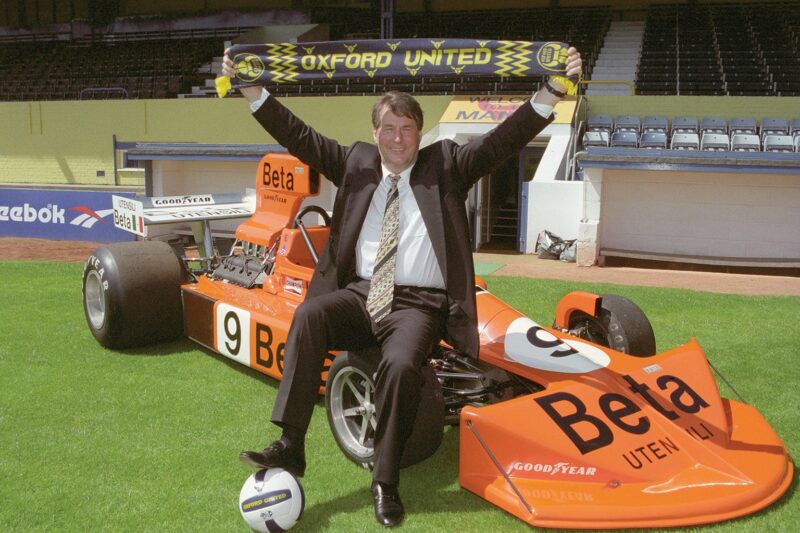
Herd’s passion for Oxford United led to him buying the team
PA
At the end of 1977 Mosley, increasingly involved with Ecclestone in the Formula One Constructors’ Association, sold his March shares to Robin, who became the sole owner of the company. “Max and I worked together for eight years, and we never had a falling-out. We disagreed about lots of things, but we could always find a way to talk through it. He is a very intelligent man. Like Bernie, he takes what he does very seriously, but he doesn’t take himself the slightest bit seriously. He has made a few enemies, of course: with him everything is black and white. I was very surprised by the sadomasochism business, because in all the years I worked and travelled with Max I knew nothing about it. I decry the way self-righteous people have gone for him over his private life. What he did was completely legal, and he and his wife had an open marriage. Everybody who really knows Max stands by him. In fact, our mutual friends regard my undying devotion to Oxford United FC as far more bizarre and masochistic than anything Max has done…
“Max and Ron Dennis never got on, of course. But I like Ron very much. We worked closely together in Formula 2 in the Project 4 days. He is a very sensitive soul, he’s insecure, but insecurity can create the driven human being. And don’t say he doesn’t have a sense of humour, because he does.”
For 1978 the F1 operation was sold to Günter Schmid of ATS, but March continued as a major force in F2, with Bruno Giacomelli blitzing the 1978 European Championship. “Bruno was quick, intelligent, a great team member, but perhaps lacking the mental strength to go all the way. He didn’t speak any English, I didn’t speak any Italian, but he was a good Catholic, so during pitstops we used to shout at each other in Latin. Of the other drivers we ran down the years, Brian Henton was very, very good. A first-class test driver: an excellent brain, understood what was going on, communicated well. My ideal driver pairing would have been Ronnie and Howden, because Howden was a good driver and a good tester, and he and Ronnie got on so well. If I couldn’t have had Howden, I’d have had Brian.
“When you work with a driver, you have to help them to believe in themselves. As a race engineer half the task is get the car to work, the other half is get the driver’s head straight. But you must never, ever bullshit. If they find out you’ve lied to them, you’ve lost them. So I made sure I worked with drivers I respected. You have to build trust, so that by the end of the season you can say, jump off this cliff, and they’ll say, when?”
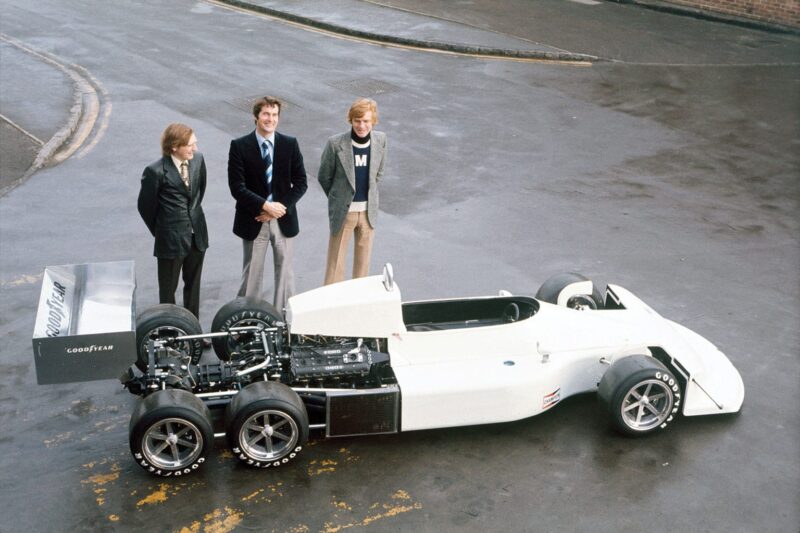
Six-wheeler never raced but was hillclimbed by Roy Lane
In 1980 March built 93 cars for F2, F3, Atlantic and SuperVee, and the same year came the first Indianapolis chassis. It didn’t work too well, but the Limeys rapidly got their heads around Indy’s special requirements, the cars became successful, and each year more and more were delivered to eager customers. In 1981 Tom Sneva led the 500, and A?J?Foyt gave March its first Indycar win at Pocono. In 1982 there were 13 Marches on the Indianapolis grid, and five of them finished in the top 10. In 1983 Teo Fabi put his March-Cosworth DFX on pole, its 207mph average comfortably a record, and Tom Sneva won the race. That year March delivered its 1000th car, an Indy chassis for Foyt, and in 1984 30 of the 33 cars on the Indy grid were Marches. From 1983 to 1987, the marque scored a five-year string of Indy 500 victories.
“There wasn’t much understanding of ground-effects then, so we started with an advantage. For an engineer, a thinker, Indianapolis is great. People say you just turn left all the time, but it’s not like that. All four corners are different, the wind direction has a big effect, and you’ve got to get the balance absolutely right, with just the tiniest bit of oversteer so you scrub off the minimum amount of speed. The track varies with temperature and how long since it rained. You can listen to a car going through a corner, hear the engine note ease from, say, G sharp to E, and you can reckon how much speed is coming off. One of the best drivers I ever worked with on ovals was Rick Mears. He never came to terms with road circuits, but on ovals he was sensational.”

Bullet-nosed 711 with tea-tray wing
Motorsport Images
By 1985 Robin was spending most of his time in the US, or in aeroplanes. “I was knackered. As I flew into Miami for the final CART race of the season, I decided it was time to get out, give motor racing up. But waiting to meet me off the flight was Cesare Gariboldi, who looked after Ivan Capelli. Ivan had just won the F3000 Championship in a March, and his Japanese sponsor Akira Akagi wanted to move up to F1.” That was the start of the Leyton House F1 team. Robin persuaded his old journalist friend Ian Phillips to be team manager: “Remarkably talented, a very strong-minded guy with a very good understanding of racing. Great fun, too.” The engines came from John Judd – “one of life’s absolute heroes”.
For 1988, long-time March employee Adrian Newey, who’d been a key part of the Indy success, produced an F1 car good enough to be the class of the non-turbos. In Portugal Ivan qualified third behind the McLarens, and passed Ayrton Senna to finish a magnificent second to Alain Prost. In Japan, on the sponsor’s home ground, Capelli qualified fourth and briefly led. “Adrian was only 29 then. He stands out as the ultimate boffin. He is incredibly demanding – ask Christian Horner – because he is such a perfectionist. Money is irrelevant to him: if money is needed, he just says, ‘get it’. But he produces brilliant cars again and again. A top man, as well as an extraordinarily nice guy.”
Meanwhile, in April 1987, March went public. Robin remained the biggest shareholder, and a block of shares was made over to key employees who had stuck with the company through thick and thin. March Group plc was initially valued at £14.5 million. “I didn’t really believe it. I’d always just been worried about being able to pay the chaps’ wages at the end of the week. Having gone public we were told, ‘Now you’ve got to get some proper businessmen in to run things, people who know how to run a factory, a proper managing director and a proper chairman.’ People tend to patronise you because you’re just a bunch of racers, not realising that the calibre of people on an F1 team is very high. I moved aside into a non-executive role, but the people who came in were idiots, and subsequently had to be fired.”
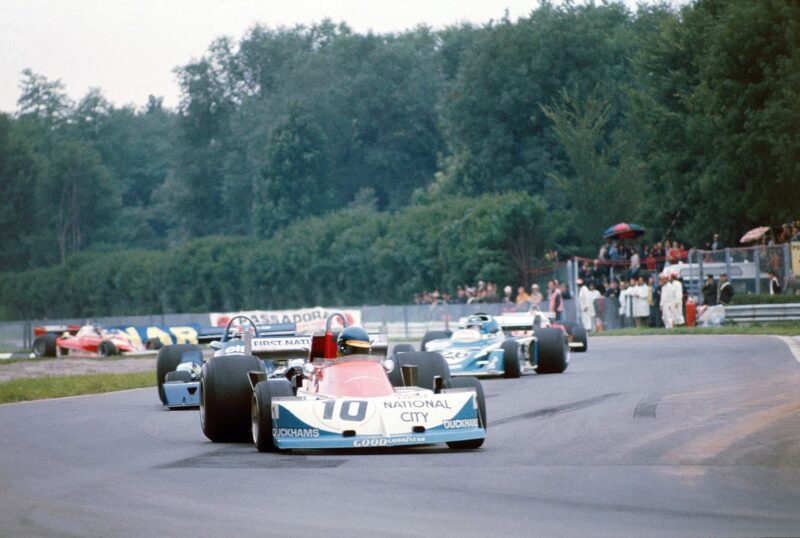
Peterson scored a brilliant victory at Monza in 1976
Motorsport Images
Things weren’t going so well in America now, and when the dollar plunged against the pound that market dried up. In other formulae, too, March was no longer flavour of the month. Taken out of the hands of the racers, the company went downhill. The situation was resolved in early 1989 when Akira Akagi’s Leyton House bought March Racing, leaving March Group plc leaner and fitter, and Robin turned his attention to other things.
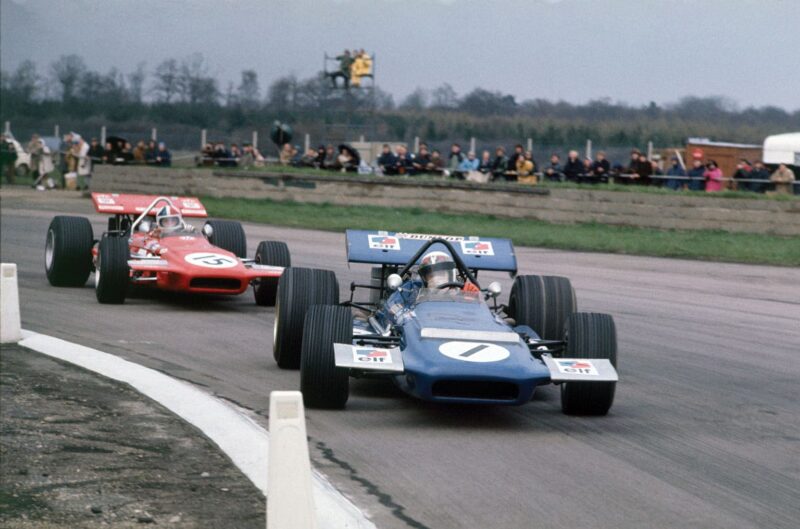
Stewart leads Amon in 701s
Motorsport Images
At lunch we concentrated on the motor racing side of Robin’s life, but late into the afternoon we were still talking, about football – as well his ownership of Oxford United during the 1990s, he nearly bought Liverpool a few years ago – and waste disposal, which is now one focus of his formidable intellect. His eyes take on a passionate glint as he describes the different procedures of his new process – sortation and pyrolysis to bring about molecular rearrangement – just as, 40 or more years ago, he would have talked about ground-effects or the torsional rigidity of Mallite. “It’s absolutely fascinating. It’s done in the absence of air, so there are no emissions. You produce a form of natural gas, which you can put through a turbine. So you’ve created energy without using any new resources, you’ve extracted all the worthwhile components of the waste, there are no emissions, and it’s carbon dioxide-neutral. I love the intellectual elegance of the cycle.
“Each of these waste sites will cost £40-£50 million, and will service a reasonable size city. Now we’ve got the first one running in North Yorkshire, the whole world wants it. But getting it off the ground was a real grind. One of life’s most dangerous sayings is, ‘If it sounds too good to be true, it probably is.’ That is just crap. At Farnborough they’ve kept the little wooden shed where Frank Whittle worked. People thought his jet engine was too good to be true, and he had 10 years of being laughed at.”
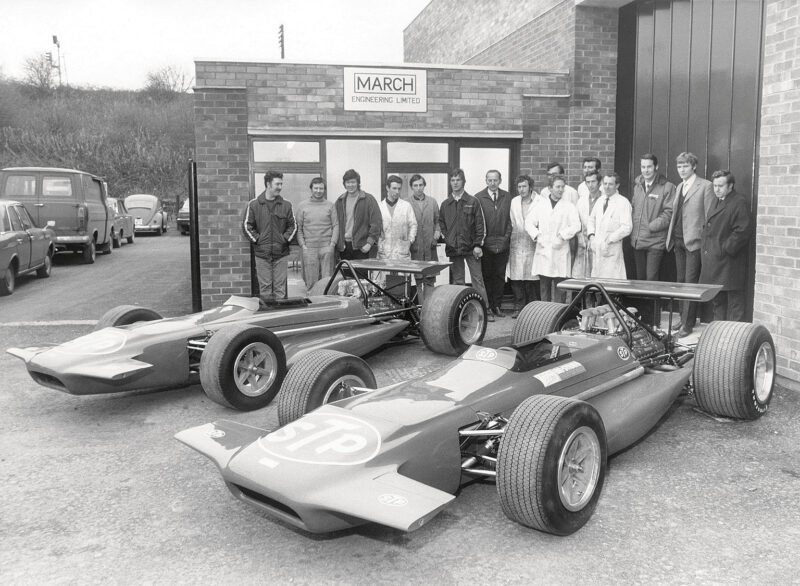
Tony team at 701 launch
Motorsport Images
Maybe high-tech waste disposal isn’t that different to Formula 1. And, even today, Robin’s old love is never very far away. “I still get at least one phone call every day about motor racing. I have to tell you, there’s only one thing more difficult that getting into F1, and that’s getting out of it…”
